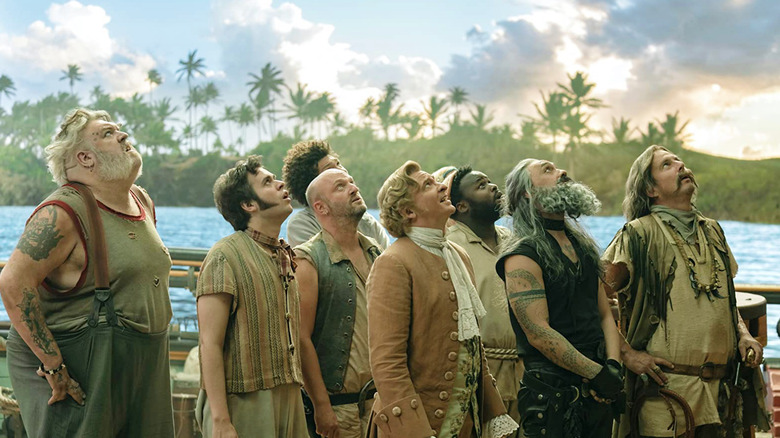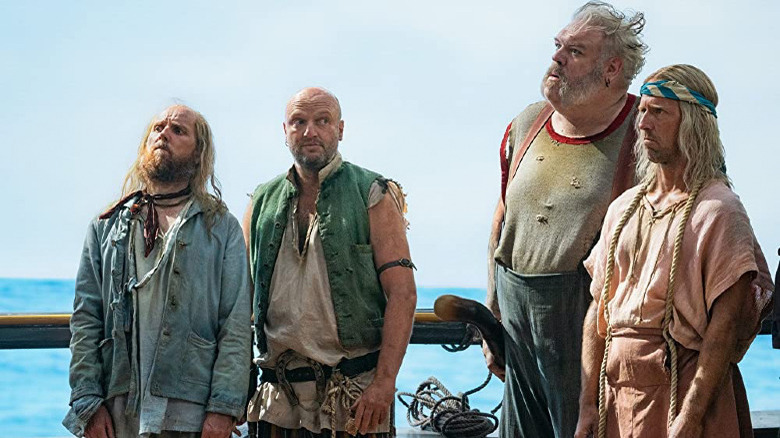The LED Screens Used In Our Flag Means Death Were So Realistic They Made The Crew Seasick
Filming on the actual ocean is incredibly difficult, as Steven Spielberg famously learned the hard way when he made "Jaws." Luckily, "Our Flag Means Death" creator David Jenkins and his crew didn't have to trek across the actual Caribbean Sea for their acclaimed pirate comedy series. No, all they needed was some cutting-edge tech to bring the Atlantic Ocean and other bodies of water to them.
Jenkins' show tells the truer-than-you'd-think story of Stede Bonnet (Rhys Darby), a mild-mannered English aristocrat from Barbados who decides to take to the high seas, dubbing himself the "Gentleman Pirate" and even finding unexpected romance along the way. The vast majority of the show takes place aboard Bonnet's sailing vessel, the Revenge, which comes complete with its own library and secret passages to closets housing Stede's winter jackets, autumn vibe, summer linen, and more. ("I'm a bit of a clothes horse," Stede admits.) Of course, as chic as its set design and costumes are, it's the way the show simulates being on the ocean that's perhaps most impressive.
In order to create this illusion, "Our Flag Means Death" filmed on sound stages with a mix of green screens and a wrap-around wall of LED panels similar to ILM's StageCraft tech (which is used to film live-action "Star Wars" series like "The Mandalorian" and "The Book of Boba Fett"). The wall looks pretty convincing on-screen but was perhaps a little too realistic in person, as one of the show's cinematographers, Mike Berlucci, told IndieWire:
"It was very immersive. It was high. I know there were a few people who got sick on it. Sea sickness."
Hitting the high LED seas
Sea sickness aside, the benefits outweigh the drawbacks when it comes to filming on sound stages with LED walls. For one, it's much easier for actors to get into the groove of things when they have an actual environment (even a virtual one) to react to, rather than a bunch of green screens. LED walls further ensure the actors are properly lit the way they would be if they were on, say, a real ocean, seamlessly replicating the ways sunlight hits the open water. On top of all that, they afford a project like "Our Flag Means Death" more freedom in terms of its visuals, allowing its crew to place the camera(s) in spots that would be trickier to access shooting on-location.
Another one of the show's cinematographers, Cynthia Pusheck, talked about this, telling IndieWire:
"The long stretch of the J [shape of the LED wall] gave us a lot of shooting options, because we knew with a comedy we'd have two and sometimes three cameras [going]. If we'd had just a flat wall that had to move around, you could have always had one angle, but in trying to really find a way to shoot this show that gave us more options, the J worked. You could do wide [shots], you could do two and three cameras, and stick on your wall."
Keep in mind, none of this is to suggest that shooting on the ocean is bad. Filming that way produced sensational results in "Jaws," while Peter Weir's visually-spectacular, $150 million 2003 epic "Master and Commander: The Far Side of the World" was shot on both the open sea and huge water tanks. Still, if you're willing to risk a little sea sickness, LED walls will nicely do the trick, too.

